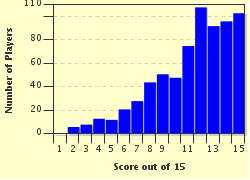Quiz Answer Key and Fun Facts
1. The extraordinary life of Josephine Baker had its humble beginning on the 3rd of June 1906. In which U.S. city, affectionately known as 'The Gateway to the West' was she born?
2. Married a total of five times in her life, many people might consider Josephine Baker to have been unlucky in love. The more superstitious amongst them might link this bad luck to her age on the first of these occasions. How old was Josephine when she first married?
3. Josephine's debut in a theatre company production was a small role in a melodrama called 'Twenty Minutes in Hell' in 1919. In which theatre, named in honour of an early civil rights leader, did this performance take place?
4. In 1921 Josephine married for the second time, a marriage that indirectly led to a major breakthrough on the way to international stardom the following year. Known for its popular tune 'I'm Just Wild About Harry', (not for dealing cards), what was the name of the Sissle and Blake production she appeared in in 1922?
5. Josephine's debut on the European stage occurred on 2nd October 1925 at the Theatre de Champs-Elysees in Paris. What was the name of this all-black review in which Josephine had the leading role?
6. One of the most iconic images of Josephine Baker comes from the 1926 stage production 'La Folie du Jour'. Often reproduced and mimicked over the years, this image is of Josephine wearing nothing more than what?
7. Owing to Josephine's fame and popularity in Europe during the Jazz-Age, casting her in movies seemed to be the next obvious step in progressing her career. Which of the following was *not* one of Josephine's films?
8. Josephine Baker had a love of animals and was often 'spotted' with a particular four legged pet both on stage and off. What type of animal was it that she named Chiquita? (Generous hint provided)
9. Having conquered Europe, Josephine made her first return trip to the United States in 1936 to appear in a revamped version of an old crowd favourite. What was the name of these shows she appeared in during her return?
10. 1939 saw war come to Europe and Josephine was determined to do her bit for the Allied cause. In which of the following ways was Josephine *not* actively involved during World War II?
11. For all of her efforts in World War II, Charles De Gaulle awarded Josephine Baker the Iron Cross.
12. Long before Brad and Angelina did the same, Josephine Baker adopted a number of orphaned children all from different ethnic backgrounds. Sometimes referred to as Baker's Dozen, what colourful pet name did Josephine give to this group of youngsters?
13. In 1963 Josephine participated in the civil rights movement's March on Washington. What unique distinction can be attributed to her appearance at this event?
14. In 1973 Josephine returned to America and, on the June 5th, began what was dubbed as her 'comeback tour'. What is the name of the legendary New York venue where the first four of these performances took place?
15. The final curtain fell for Josephine Baker on 12th April 1975; and she was given a state military funeral in Paris three days later. Given that her final resting place is in a Principality, where would you have to go in order to view Josephine's grave-site?
Source: Author
Aussiedrongo
This quiz was reviewed by FunTrivia editor
Nannanut before going online.
Any errors found in FunTrivia content are routinely corrected through our feedback system.

